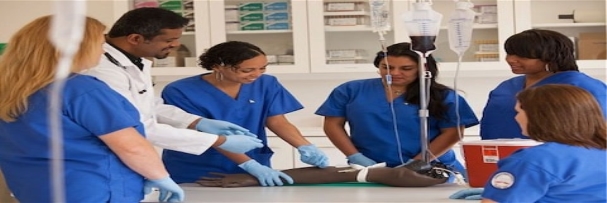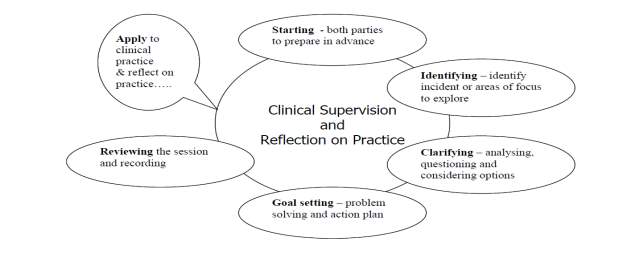Clinical Supervision and Mentorship in Nursing
Info: 6921 words (28 pages) Dissertation
Published: 8th Sep 2021
CLINICAL SUPERVISION AND MENTORSHIP IN NURSING: A WAKE-UP CALL FOR NIGERIAN NURSES
What is supervision?
Supervision could be described as teaching of specific skills and competencies by assisting the learners to develop self-sufficiency in knowledge and skills in their area of interest. This sometimes could also include some form of assessment (London Deanery, 2012).
Clinical supervision could be described as an activity that brings a student/learner and a skilled professional together in an active knowledge and skill transfer that could enhance the professional development of the student/leaner in the clinical area.
Butterworth (1992) defined clinical supervision as an exchange of skills and knowledge between practicing professionals in an attempt to advance professional competencies.
In nursing, it has been endorsed as a method of ensuring safe and accountable practice (Freeman, 2006). It is a learning process in which a less experienced nurse cooperate with a more experienced colleague in order to become more skilled, improve his or her own practice and to enhance a continuous professional growth.

Fig 1 showing a senior nurse training other young nurses
Adapted from Royal Nursing home (2006)
In general context, clinical supervision could be defined as a period of knowledge and skill transfer between a skilled professional to students in training section, or when a skilled nurse transfers his/her technical know-how to a subordinate, interns, mentee or a student on clinical posting.

Fig 2 showing different professionals in training
Adopted from Sunday Observer (2017)
National Health Scheme Management Executive (1993, as cited in Nursing Midwifery Council of United Kingdom (2006)) defined clinical supervision as a formal process of professional learning and support that enables individual practitioners to acquire knowledge and develop competence, assume responsibility for their own practice and enhance consumer protection and safety of care in complex situations.
HISTORY OF SUPERVISION
To my own opinion, the tradition of supervision was an age-long practice used by our fall fathers to ensure that their works were done according to their lay down standard or instructions.
Supervision history as a formal activity carried out by educational administrators within a school system begun in 1830s in the United States of America, when city schools system were formed due to population growth in major cities (State University, 2017). The superintendents were assigned initially to inspect the schools and make sure that prescribed curriculums were followed by teachers and students could also recite their lessons. Springing up of many schools later made it impossible to for the superintendents to continue their supervision and the duty was later delegated to the school principals.
In the second half of the 18th century, the field of supervision developed to various forms of clinical supervision which was developed by professors from Harvard University called Morris Cogan and Robert Anderson and their graduate students which they later became professors of supervision in other universities.
Robert Goldhammer in 1969 proposed five-stage process of clinical supervision which are:
- Pre-observation conference between teachers and supervisor concerning the elements of learning to be observed
- Classroom observation
- Analysis of supervisors’ comments during observation and post-observation conference planning.
- Teachers and supervisors’ post-observation conference.
- Analysis of post-observation conference by the supervisor
These stages were further reduced to three stages by most of the practitioners as follow:
- Pre-observation conference
- The observation
- Post-observation conference
Clinical supervision model of Brigit Proctor 1986 (as cited in Cutcliffe, Butterworth, & Proctor, 2001) categorizes clinical supervision into 3 functions
Formative function (Educational/Learning) – Formative focuses on reflective/deep learning that is concerned with developing abilities, skills and understanding of the supervisee or practitioner. It also enables professionals to identify strength and weakness in their practice and to further develop knowledge and skills to bridge theory with practice in a critical way.
Restorative function (Supportive) – This focuses on supportive relationship that could help the supervisee and supervisor respond to emotional stress of working and caring for their clients, thereby reducing distress arising from stressful situation and relationships.
Normative function (Accountability/Managerial) – This focuses on maintenance and adherent to standard, safe practice, development of standard and ensuring the effectiveness of supervisee/subordinate on his/her daily work schedule.
Decades ago, the nature of clinical supervision has been to watch and control the supervisee by the supervisor in practice (Sood & Driscoll, 2004).

Fig 3 showing nurses in training working in the ward
Adopted from Royal Nursing home (2006)
Clinical supervision should go beyond control and watch for mistakes of supervisee, but should be a dynamic and collaborative process of teaching and mentoring which goes beyond mere nurturing role (Freeman, 2006).

Fig 4 showing collaborative teaching between a nurse-supervisor and supervisee
Adopted from Department of Health (2015)
Benefits of clinical supervision
- It enhances personal development and growth of the supervisee
- It detects learning needs of the interns/students
- It improves working relationship between nurses
- It helps supervisees to reflect on practice
- It provides opportunity to link research to practice
- It enhances quality of care for clients
- It improves client’s satisfaction
- It maintains and safeguard standards
- It decreases adverse occurrence incidents
- It protects patients receiving care from malpractice and it also protects nurses from litigation (Baker, 1992)
Why is clinical supervision needed?
- For dynamic changes within current health care system
- Because of increased professional expectation from the public
- Because of awareness and increased need for risk reduction in modern health care services (Tingle, 1995).
- Increased need to be up-to-date on innovations in medical management and patient’s treatment (Kohner, 1994)
- To fulfil the professional regulatory body’s educational and practice requirement.
- To protect the interest of the public
- For continuous professional development
- Development of multi-professional co-operation
- Growing need for professional accountability
- To fast-track organizational change
- Growing demand for evidence based practice
- For development of independent practitioner role
- Shifting of nursing profession from task oriented toward more individualized approach.
Clinical supervision approach
According to Barton-Wright (1994), clinical supervision can come in different ways
- One-to-one sessions – This approach could be in form of expert supervisor to a beginner/learner
- Group supervision – This could be in form of expert supervisor to group of students/interns (preceptor – A faculty member who supervises students in clinical area)
- Self-supervision – This is a form of supervision where the individual reflects upon his/her work.
- Team supervision – This happen among a group of colleagues who work together e.g. community nurses
Supervisors have responsibilities that include the following:
- Mentoring the new students/interns to facilitate their supportive introduction or induction into the profession
- Bringing students to minimum standards of effectiveness
- Improving individual intern/student competencies regardless of how skilful they are deemed to be.
- Working with groups of interns/students in a collaborative effort to improve their learning.
- Working together with lecturers or teachers on adaptation of curriculum to meet the needs of various students in line with the national and international standard
Clinical supervision should be a mentoring process which should include appraisal or individual’s performance review, in order to be in line with organization’s policy, guideline and procedures expected of a professional in a constantly changing and complex healthcare environment.
Who is a mentor?
A mentor is a distinct or special helper who works with others in a constructive and positive ways, so that both the mentee and mentor would have ability to develop together through the relationship (Indiana University Bloomington, 2016).
A mentor could be described as a guide, facilitator, tutor, coach, trusted advisor, and a counsellor. A mentor is a person who is ready to use his or her expertise and time to develop and guide another person (Nobscot Corporation, 2016).
 Telegraph, 2017)
Telegraph, 2017)
According to Kerry and Mayes (1995) (as cited in Gopee, 2011), the definitions of mentor need to include the following:
- nurturing;
- role modelling;
- functioning (as teacher, sponsor, encourager, counsellor and friend);
- focusing on the professional development of the mentee; and
- sustaining a caring relationship over time.
Who is a Mentee?
A mentee could be described as eager learner, student, apprentice, intern and protégé. A mentee is a person who is eager to learn or seek advice from a valuable and well experienced individual in order to personally grow in a particular profession (Mentor scout, 2016).
Brief history and development of mentoring
The word mentor comes from the character “Mentor” in Homer’s epic tale, The Odyssey. Mentor was a trusted friend of Odysseus, the king of Ithaca. When Odysseus fought in the Trojan War in another country, he called on his trusted friend called Mentor to serve as a friend, guide and advisor to his son Telemachus. Mentor was an older, wiser, a fatherly person acting as a trusted advisor, training his son by sharing experience, knowledge and wisdom with him. (Tarheel Challenge Academy, 2014).
According to Simpson and Weiner (1989) (as cited in Gopee, 2011) the word men-tor also relates to the Latin word ‘mens’ that is, pertaining to, or occurring in the mind. Riverside Webster’s II New College Dictionary (1995) defines a mentor as “a wise and trusted teacher or counsellor”. The act of mentoring is a series of ongoing and little successes. You will be able to make a real impact through consistent and ongoing relationship building.
Mentorship
Mentorship is sharing of knowledge and expertise through a special relationship between a mentor and a mentee (Nobscot Corporation, 2016). The relationship could be formal with their goals clearly written out together with scheduled meeting periods, or it could be informal with exchange of ideas through occasional meeting periods, occasional conversation or exchange of email. Nursing could be described as a stressful profession, and nursing students and newly qualified nurses need strong support and guidance to cope with integration into the profession (Bawadi, Norrie, & Debbie). Mentorship is an important resource for students; a well-functioning student–mentor relationship supports students’ and nurses’ professional development .(Shen & Spouse, 2007) Clinical teaching expertise and quality mentorship are both vital to the clinical training and internship experience of students. Nurses who take the mentor role should have special qualities
Clinical supervision is a combined process of teaching and mentorship. According to (Freeman, 2006) The process may empower the supervisee as follow:
- Maintain and promote standards and innovations in practice in their own interest, interest of their client and their organization.
- It gives them time to involve in critical self-examination and reflect on their practice.
- To recognize practice challenges and to involve evidence based practice to overcome their challenges.
- To be more confident in their competences in clinical practice.
- To put their patient/client at the central of their care, and take perception and responses of their patients to their interventions with empathy.
- It makes supervisee to be challenged in a safe environment (supervisor’s presence will boost their confidence)
- It may challenge supervisee to consider further training in a specialty of their interest for their personal professional advancement
Preceptorship – Clinical supervision must not be confused with preceptorship. In preceptorship, a preceptor is assigned to a newly qualify or newly employed professionals to facilitate learning and teaching process needed to fulfil/gain competencies needed for the post. The period for this process usually last between 4-6 months. It is also called adaptation in some organizations and it also involve act of mentoring and coaching.
Mentors can provide two main sources of support for protégés namely instrumental support and psychosocial support (Kram, 1985; Noe, 1988; Ragins & McFarlin, 1990)
Instrumental support – Instrumental support also referred to as career-related or vocational support, involves those aspects of the relationship that enhance proteges’ career advancement. This includes the mentor acting as a sponsor, coach, and protector, in addition to providing exposure, visibility, and challenging job assignments.
Psychosocial support – Psychosocial functions include serving as a role model for proteges and providing counselling, friendship, and advice (Eby, McManus, Simon, & Russell, 2000).
A well-organized mentoring or clinical supervision programme provides students, interns, new employee or a mentee with a mentor that will share his/her expertise and professional knowledge with them in the field (Franchise Growth Partners, 2011). Like any other profession, a good nurse supervisor is always available to answer any questions relevant to the profession. Good mentor-mentee relationships are in two ways which may be positive or negative.
Clinical teaching expertise and quality mentorship are both vital to the clinical training and internship experience of students. Nurses who take the mentor role should have special qualities (Bawadi et al.). From experience, career nurses who are already at the management cadre in Nigerian health institutions are so insulated in their own little world and they don’t feel the younger ones’ pains and other difficulties they are enduring in order to fulfil their aspirations and dreams. Rather, they complicate the already tensed situation and make the younger ones feel like no body by coercing them, become unfriendly and unapproachable to them whenever they want to go for higher education, and thereby chattered their hopes of fulfilling their professional dreams. Being a chief nursing officer is erroneously viewed by some nurses as handing them a ticket to the big leagues, to greater visibility, exciting assignments and big promotion as they enjoy broader influence over their protégés. Attitude, either good or bad can be passed like a virus throughout the ranks. If a mentor allows mentee to wander around the working place with acidic fuming frame of mind, that is an open invitation to increased restlessness within the ranks (Huddleston & Huddleston, 2009).
THE WORK OF A MENTOR
According to University of Wolverhampton Business School (2009), the work of a career nurse is like a fundamental work of a mentor which are as follow
- Managing relationship
- Encouraging
- Nurturing
- Teaching
- Offers mutual respect
- Responding to mentees needs
- Supports at all times
These are bridge and represented in fig. 1 below

Fig 1: Qualities of a mentor
Adapted from: University of Wolverhampton Business School (2009)
Franchise Growth Partners (2011) outlined the qualities of a good mentor and a good clinical supervisor who is a mentor must possess the same qualities as follow:
Willingness to share knowledge, skills and expertise.
A good clinical supervisor who is a mentor will accept the current supervisees’ level of professional development and teach them what he/she knows that would further develop their expertise. He/she also recognizes that mentoring requires commitment and time and is ready to commit that for the benefit of the supervisee.
He/she acts as a role model
A good clinical supervisor and a mentor shows student/interns what it takes to be successful and productive in nursing through their behavior and personal attributes.
He/she has personal interest in mentoring.
Mentors take their responsibilities as mentors seriously. They are devoted to the success of their mentees. They are devoted to success of the mentee. They are compassionate, knowledgeable and possess quality of a good teacher. They are committed to helping mentee to achieve success by empowering them to develop their own strength, personal attributes and believes.
Exhibits enthusiasm in their mentorship.
Enthusiasm would catch the interest of the inters, student or mentee with dedication. The interns/student wants to belief that their profession has meaning and ability to create good life for them.
Must value continuous growth and learning in their profession.
Anyone that is stagnant in their current position cannot be a good mentor. Good mentors are open and committed to exploring and experimenting learning practices that are new to their profession. Effective mentor must be a respected professional that is highly skillful, and a role model to others (Jokelainen, Turunen, Tossavainen, Jamookeeah, & Coco, 2011). They read and also publish in professional journals on subjects in the area of their expertise. They also attend workshops and professional updates.
Provides constructive feedback and guidance.
A good mentor provides guidance and constructive feedback to their protégé. This will help the mentee to grow significantly by identifying their strength and weakness. This will enable them to work more on their weaknesses and make them more successful in the field.
He/she is respected by other employees and colleague at all organization’s level.
Normally, mentees wish to be in the position of their mentors in the future and they always look up to them for guidance. Mentee wants to follow a well-respected person in their organization and whose contributions to their profession is well appreciated by many.
Set and meets ongoing professional and personal goals.
A good mentor continuously demonstrates to be a good example by always setting personal and professional goals with success.
Values the initiatives and opinions of others.
A good mentor values and appreciate team work. He/she also appreciate the efforts of mentees and empower them to do more.
Motivates others as a pace setter.
A good mentor motivates others by setting a good example for others to follow
Counterproductive Behaviours in clinical supervision
A nurse supervisor would want his/her subordinates, interns or nursing students to be effective, productive, achieving, successful, and happy. Criticizing them is counterproductive and may harm a good mentoring relationship (Chandler, Lillian, & McManus, 2010). It is very important to note that supervisor/mentor’s comments and actions could have a significant impact, either positively or negatively on self-image and confidence of their mentee (Pcaddick, 2009). Criticism is evaluative and judgmental, regardless of how it is delivered. Its outcome could create fear and hesitation on the inters/students. As a nurse-mentor, think through how best you could provide difficult negative-feedback to your mentee without criticizing them.
Constructive feedback – Constructive feedback should be issue focused, information-specific, and based on observations. According to Hebert (2015), it usually comes in two forms which are positive constructive feedback and negative feedback.
- Positive constructive feedback is news or input about an effort well done.
- Negative feedback is news about an effort that needs improvement.
Criticism and praise – Criticism and praise are personal judgment about an outcome of a performance or effort. The praise is favourable while criticism is unfavourable judgement. Information given during criticism could be sometimes vague, based on feelings or opinion , and could be generally not objective. This why caution must be made before criticizing inters/students.
Clinical supervisory mode – The mode of clinical supervision depends on the way the process is operationalized. It could be either individual or group supervision
It could be regular one-to-one section with a supervisor
Regular group section with a supervisor
Network supervision with different supervisors or other health professionals
whichever the process that an institution decides to use, it must comprise the following elements in the circle below
Clinical supervisory circle

Adopted from (Freeman, 2006)
Responsibilities of supervisee
Supervisee is expected to use clinical supervision session in the most effective way
Adequate preparation for clinical supervision sessions by identifying challenges that supervisor could assist mentee to solve.
Follow up on action plans that arise during clinical supervision.
Punctuality on the part of the supervisee and making clinical supervision appointment time a priority.
Proper arrangement of duty and responsibilities so that the supervisee will always be free on duty during clinical presentation time.
Supervisee should be opened to challenge and not interpreting all challenges as a personal attack
Given constructive feedback to the supervisor on their clinical supervisory section, especially those things that are helpful or not so helpful.
Avoiding nonproductive conversations
Supervisor’s responsibilities (Bond & Holland, 2011)
- When preparing for the clinical supervision session, settle down on time and make adequate preparation for the session, remember the previous session, ensure no interruption.
- Be reliable and stick to agreed appointment time, respect contracts terms, keep confidentiality
- Avoid any other role like managerial or other assignment to encroach to the clinical supervision session. Other roles must be attended to at other times. The session must keep to the specified time
- Control inappropriate demand that could cause outside interference from the intern/student during the session.
- Focus on how quality professional practice can be sustained regardless of personal difficulties the intern/student may have.
- Advise supervisee to seek specialist help or advice when necessary
- Challenge and correct any unruly behaviour displays or talks that gives you concerns about supervisee practice.
- Ensure that you have support, e.g from your management or school.
- Attend professional updates
In an overall interest of nursing profession in Nigeria, a career nurse must always remember the following facts.
Building a good relationship with an employee is the best way to close the employee’s productivity gap. No other single responsibility demands more attention than your responsibility to build and maintain a productive relationship with each employee under your immediate supervision (Drury, 2008). A working relationship is not an opportunity for you to provide your subordinates how difficult it was to work under some past leaders, how difficult your past working conditions were, and bad experiences you have had during the course of your career progression. Rather, its purpose is to provide a safe working place for your subordinates to learn the ideal things from you. Remember, the way you were brought up is likely to be the way you will bring others up unless there is an intervention to change your orientation!
Mentoring Challenges
Due to the current trend of educational advancement in nursing profession in Nigeria, many career nurses who previously never thought of mentoring are now eager to help others achieve their goals with the aim of giving back to the profession by helping the young nurses to achieve their professional dreams. There are four frequent challenges of being a career nurse and a mentor which are, according to Diego (2013):
Time management: – With the busy everyday work schedule of a career nurse in the ward, how to combine their busy daily activities with active mentoring is a major challenge. Since the greatest reward for being a mentor is the success of the mentee, therefore all the obstacles or challenges are well worth understanding (Diego, 2013). It is the best to define the amount of time a nurse is willing to contribute to mentoring subordinates every day in order not to get stuck.
Poor motivation: – Poor motivation/encouragement on the part of Hospital/School management and professional colleagues kills the spirit/willingness of a passionate career nurse who is willing to be a mentor to others.
How to keep focused: – Keeping focused is very essential so that irrelevancies are not drawn into the teaching/mentoring sessions of the inters, student-nurses or subordinates. Just the same way to control the mentoring time, a good nurse-mentor should keep the mentee focused with clear direction. If mentees are committed to their purpose, they will work hard to get the most benefit out of their valuable time, and not head off in irrelevant directions.
Goals setting: it will be difficult to set mutual goals for mentoring when the mentee doesn’t know where they are going. As a nurse-mentor, it is good to set goals for the mentoring journey.
To be a good clinical supervisor/nurse-mentor, it is important to have the following facts at the tips of one’s fingers
A good clinical supervisor/nurse-mentor should be a person willing to be part a diverse and supportive community of learners, willing to share expertise, experience and weakness (Indiana University, 2016). A nurse-mentor believes in continuous learning as a life-long adventure. A nurse-mentor accepts professional and personal responsibilities challenges of helping. A good mentor seeks A mentor seeks essential training, supervision and support because we grow, learn and be accountable professionals. We would also be able to replicate those professional values to those we are mentoring and training. A mentor is someone who has learned through challenges and success. A mentor realizes that respect is always earned and not something sinly demanded or expected. A mentor accepts others in humanity, realizing that ‘to err is human and to forgive divine (Indiana University, 2016).
Recommendations
- There should betraining and retraining of clinical supervisors and nurse managers on their roles as a career nurse and a mentor in Nigeria.
- The importance of mentoring must be stressed in all nursing institutions in Nigeria, in order to change the orientations of many nurses and to also reshape their attitudes, thereby enabling them assume their roles as a good mentor.
- Mentorship should be added to the nursing management course curriculum and taught in all nursing training institutions in Nigeria.
- Mentorship processes should be strictly used to train the university graduates of nursing science during their one-year internship programme in Nigeria.
REFERENCES
Baker, S. E. (1992). The nurse practitioner in malpractice actions: standard of care and theory of liability. Health Matrix, 2, 325.
Barton-Wright, P. (1994). Clinical supervision and primary nursing. British journal of nursing (Mark Allen Publishing), 3(1), 23-25, 28-30.
Bawadi, H., Norrie, P., & Debbie, M. D. Student Nurses’ Perceptions of a Good Mentor: A Questionnaire Survey of Student Nurses in the UK, USA and Jordan.
Bond, M., & Holland, S. (2011). Skills Of Clinical Supervision For Nurses: A Practical Guide for Supervisees, Clinical Supervisors and Managers: McGraw-Hill Education.
Butterworth, T. (1992). Clinical supervision as an emerging idea in nursing. In T. Butterworth & J. Faugier (Eds.), Clinical Supervision and Mentorship in Nursing (pp. 3-17). Boston, MA: Springer US.
Chandler, D. E., Lillian, E., & McManus, S. E. (2010). When Mentoring Goes Bad. The Wall Street Journal.
Cutcliffe, J. R., Butterworth, T., & Proctor, B. (2001). Fundamental themes in clinical supervision: Psychology Press.
Department of Health. (2015). Restrictions on nurse recruitment from overseas changed Retrieved from https://www.gov.uk/government/news/restrictions-on-nurse-recruitment-from-overseas-changed
Diego, C. C. (2013). Be a Leader by Leaders For Leaders:The Four Greatest Challenges of Mentoring. Retrieved from http://changeyourgamebealeader.com/2013/10/01/four-greatest-challenges-mentoring/
Drury, D. (2008). The Supervisor-Employee Relationship. Retrieved from http://wps.prenhall.com/wps/media/objects/6280/6430931/11e/C05.pdf
Eby, L. T., McManus, S. E., Simon, S. A., & Russell, J. E. (2000). The protege’s perspective regarding negative mentoring experiences: The development of a taxonomy. Journal of Vocational Behavior, 57(1), 1-21.
Franchise Growth Partners. (2011). Qualities of a Good Mentor. Retrieved from http://franchisegrowthpartners.com/mentoring
Freeman, C. (2006). Clinical Supervision Guidelines for Registered Nurses. Retrieved from http://www.supervisionandcoaching.com/pdf/page2/CS%20Guidelines%20(Birkenhead%20&%20Wallasey%20PCT%20-%20UK%202005).pdf
Gopee. (2011). Effective Mentoring. Retrieved from The Concept of ‘Mentoring’ website: http://www.sagepub.com/sites/default/files/upm-binaries/39882_9780857024190.pdf
Hebert, M. (2015). Giving Feedback. Retrieved from Marcia Hebert’s Blog website: http://www.marciahebert.com/2015/01/giving-feedback-part-two/
Huddleston, D. C. C. N. D. M. L., & Huddleston, M. L. (2009). The Manufacturing of a Dream: Xulon Press.
Indiana University. (2016). Who is a Mentor? Retrieved from http://www.indiana.edu/~omsld/whoismentor.php
Indiana University Bloomington. (2016). About Mentoring. Retrieved from http://www.indiana.edu/~omsld/whoismentor.php
Jokelainen, M., Turunen, H., Tossavainen, K., Jamookeeah, D., & Coco, K. (2011). A systematic review of mentoring nursing students in clinical placements. Journal of Clinical Nursing, 20(19‐20), 2854-2867.
Kohner, N. (1994). Clinical supervision. Nursing Management, 1(3), 9-9.
Kram, K. (1985). Mentoring at work. Glenview. IL: Scott Foresman.
London Deanery. (2012). Clinical and Educational Supervision. Retrieved from Multiprofessional Faculty Development website: http://www.faculty.londondeanery.ac.uk/e-learning/supervision/clinical-and-educational-supervision
Mentor scout. (2016). Who is a Mentor. Retrieved from http://www.mentorscout.com/mentor.cfm
National Health Scheme Management Executive. (1993). Clinical Supervision. Retrieved from http://www.supervisionandcoaching.com/pdf/page2/CS%20Advice%20Nursing%20Midwifery%20Council%20(UK)(2006).pdf
Nobscot Corporation. (2016). Mentor Scout: Mentor Definitions. Retrieved from https://mentorscout.com/about/mentor.cfm
Noe, R. A. (1988). An investigation of the determinants of successful assigned mentoring relationships. Personnel psychology, 41(3), 457-479.
Pcaddick. (2009). Building Effective Mentoring Partnerships. Retrieved from http://pcaddick.com/page7.html
Ragins, B. R., & McFarlin, D. B. (1990). Perceptions of mentor roles in cross-gender mentoring relationships. Journal of Vocational Behavior, 37(3), 321-339.
Riverside Webster’s II New College Dictionary. (1995). Webster’s II new college dictionary. Boston: Houghton Mifflin Co.
Royal Nursing home. (2006). Sri Lanka Nursing School Vocational Nurses Training Center (VNTC). Retrieved from http://www.royalnursinghome.com/nurses_training.html
Shen, J., & Spouse, J. (2007). Learning to nurse in China–Structural factors influencing professional development in practice settings: A phenomenological study. Nurse Education in Practice, 7(5), 323-331.
Sood, A., & Driscoll, J. (2004). Clinical Supervision in Practice: A Working Model. Retrieved from http://www.supervisionandcoaching.com/pdf/page2/CS%20%26%20Radiography%20(Driscoll%20%26%20Sood%202004).pdf
State University. (2017). Supervision of Instruction – The History of Supervision, Roles and Responsibilities of Supervisors, Issues Trends and Controversies. Retrieved from http://education.stateuniversity.com/pages/2472/Supervision-Instruction.html
Sunday Observer. (2017). Employment and Services. Retrieved from Sunday Observer website: http://www.sundayobserver.lk/2017/09/03/classifieds/employment-services
Tarheel Challenge Academy. (2014). What is a Mentor and Roles of the Mentor and Mentee. Retrieved from http://nc-tcachallenge.org/mentor-training-module-3/
Telegraph. (2017). Health Editor. Retrieved from http://www.telegraph.co.uk/news/2017/06/12/number-eu-nurses-coming-uk-falls-96-per-cent-since-brexit-vote/
Tingle, J. (1995). Clinical supervision is an effective risk management tool. British journal of nursing (Mark Allen Publishing), 4(14), 794.
University of Wolverhampton Business School. (2009). A Managers’ & Mentors Hand Book on Mentoring. Wolverhampton: University of Wolverhampton.
Cite This Work
To export a reference to this article please select a referencing stye below:
Related Services
View allRelated Content
All TagsContent relating to: "Teaching"
Teaching is a profession whereby a teacher will help students to develop their knowledge, skills, and understanding of a certain topic. A teacher will communicate their own knowledge of a subject to their students, and support them in gaining a comprehensive understanding of that subject.
Related Articles
DMCA / Removal Request
If you are the original writer of this dissertation and no longer wish to have your work published on the UKDiss.com website then please:




